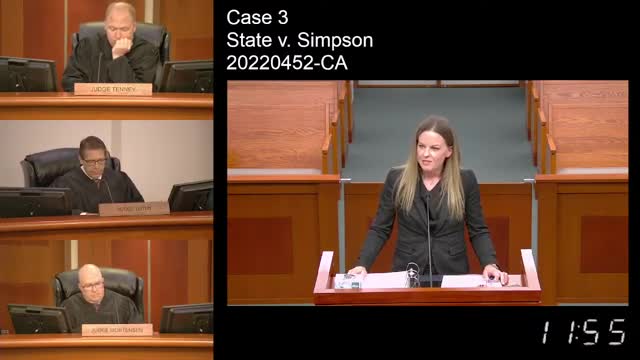Court reviews evidence admissibility in Gabrielle Simpson sexual assault trial
November 21, 2024 | Utah Court of Appeals Live Stream, Utah Appellate Court, Utah Judicial Branch, Utah
This article was created by AI summarizing key points discussed. AI makes mistakes, so for full details and context, please refer to the video of the full meeting. Please report any errors so we can fix them. Report an error »

The Utah Court of Appeals convened on November 21, 2024, to address significant legal arguments surrounding the admissibility of evidence in a case involving defendant Simpson, who faced charges of sexual assault. The court's discussions primarily focused on the application of Rules 404(b) and 403 of the Utah Rules of Evidence, particularly regarding the admissibility of prior bad acts and the balancing of probative value against prejudicial impact.
The proceedings began with the defense arguing that the trial court had erred in admitting evidence under Rule 404(b), which pertains to the admissibility of evidence of other crimes, wrongs, or acts. The defense contended that the trial court failed to adequately weigh the competing inferences of the evidence presented, which they claimed led to jury prejudice. They asserted that the jury was not properly instructed on how to use the evidence, particularly in determining whether the accuser, Claire, was fabricating her claims.
The court engaged in a detailed examination of the standards for assessing similarity between incidents under Rule 404(b). The defense highlighted that the incidents cited by the prosecution were not sufficiently similar to be probative, arguing that the trial court's findings were clearly erroneous. The justices questioned whether the assessment of similarity should be treated as a factual determination or a discretionary one, with implications for how much deference should be given to the trial court's ruling.
The prosecution countered that the evidence was presumptively admissible and that the trial court had appropriately considered the probative value of the evidence in light of the defense's claims of fabrication. They argued that the similarities between the incidents were sufficient to reduce the likelihood that the accusations were fabricated, thus supporting the admissibility of the evidence.
Throughout the discussions, the justices grappled with the implications of jury instructions and whether the trial court's failure to provide specific guidance on the use of evidence constituted an abuse of discretion. The defense maintained that the jury was left without clear direction on how to interpret the evidence, which could have led to an improper basis for their decision.
As the hearing progressed, the court acknowledged the complexity of balancing probative value against potential prejudice, particularly in cases involving sensitive allegations such as sexual assault. The justices expressed the need for clarity in how such evidence is presented and interpreted in court, emphasizing the importance of proper jury instructions to mitigate any unfair prejudice.
In conclusion, the Utah Court of Appeals deliberated on critical issues regarding evidentiary standards and jury instructions in sexual assault cases. The outcome of this case could have significant implications for how similar cases are handled in the future, particularly concerning the admissibility of prior acts and the necessity for clear jury guidance. The court's decision is anticipated to clarify the application of evidentiary rules in the context of sexual assault allegations.
The proceedings began with the defense arguing that the trial court had erred in admitting evidence under Rule 404(b), which pertains to the admissibility of evidence of other crimes, wrongs, or acts. The defense contended that the trial court failed to adequately weigh the competing inferences of the evidence presented, which they claimed led to jury prejudice. They asserted that the jury was not properly instructed on how to use the evidence, particularly in determining whether the accuser, Claire, was fabricating her claims.
The court engaged in a detailed examination of the standards for assessing similarity between incidents under Rule 404(b). The defense highlighted that the incidents cited by the prosecution were not sufficiently similar to be probative, arguing that the trial court's findings were clearly erroneous. The justices questioned whether the assessment of similarity should be treated as a factual determination or a discretionary one, with implications for how much deference should be given to the trial court's ruling.
The prosecution countered that the evidence was presumptively admissible and that the trial court had appropriately considered the probative value of the evidence in light of the defense's claims of fabrication. They argued that the similarities between the incidents were sufficient to reduce the likelihood that the accusations were fabricated, thus supporting the admissibility of the evidence.
Throughout the discussions, the justices grappled with the implications of jury instructions and whether the trial court's failure to provide specific guidance on the use of evidence constituted an abuse of discretion. The defense maintained that the jury was left without clear direction on how to interpret the evidence, which could have led to an improper basis for their decision.
As the hearing progressed, the court acknowledged the complexity of balancing probative value against potential prejudice, particularly in cases involving sensitive allegations such as sexual assault. The justices expressed the need for clarity in how such evidence is presented and interpreted in court, emphasizing the importance of proper jury instructions to mitigate any unfair prejudice.
In conclusion, the Utah Court of Appeals deliberated on critical issues regarding evidentiary standards and jury instructions in sexual assault cases. The outcome of this case could have significant implications for how similar cases are handled in the future, particularly concerning the admissibility of prior acts and the necessity for clear jury guidance. The court's decision is anticipated to clarify the application of evidentiary rules in the context of sexual assault allegations.
View full meeting
This article is based on a recent meeting—watch the full video and explore the complete transcript for deeper insights into the discussion.
View full meeting

